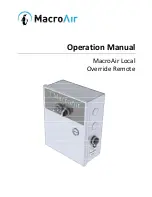
Care and Cleaning
Periodic cleaning of your new ceiling fan is the only maintenance that is needed. Use a soft brush
or lint free cloth to avoid scratching the finish.
• Do not use water when cleaning your ceiling fan, it could damage the motor or the blades and
create the possibility of an electrical shock.
• Motor has permanently lubricated ball bearings. No need to oil.
• This fan is not intended for use by young children or infirm persons without supervision.
• Do not allow young children to play with the fan.
Wobble
• Ceiling fans tend to move during operation due to the fact that they are not generally rigidly
mounted - if they were, they could generate excessive ceiling vibration and stress on their
mountings.
• Movement of a couple of centimetres is quite OK and does not suggest the fan will fall down.
• Ceiling fans are mounted very securely on steel brackets with rubber cushioning or with ball
joints to allow free movement.
• Please note that all ceiling fans are not the same, even in the same model
- some may move
more or less than others.
The following procedures should eliminate any wobble. Check for wobble after each step. It is
impossible to eliminate wobble completely.
a. Check that all blade brackets are tightened securely.
b. Most wobble problems result from inconsistent blade level. To check blade level, measure the
distance from each blade tip to the ceiling. If measurements are inconsistent, adjustments of
brackets will be required.
c. Wobble problem could also result from deviations in distance from blade to blade. To check
blade separation, measure the distance from blade tip to blade tip. Should measurements vary,
loosen screws connecting blades and brackets (one at a time) then shift blade to proper position
and re-tighten screws.
Cleaning and Maintenance
The fan is operated from the wall mounted control switch.
It has 3 speed positions and an off position.
Turn the knob to the desired speed position to activate the
fan and to off to stop it.
Summer/Winter Operation
This fan incorporates a reversing switch. The switch is
located on the side of the lower canopy, just above the
motor and blades. With the switch set to the upper position
(marked “S” or Summer) air flow is directed downward.
This is best for cooling in summer. With the switch set to
the lower position (marked “W” or Winter) air flow is
directed upwards. This is best for winter operation, and can
assist in moving heated air around the room.
Operating Instructions






























